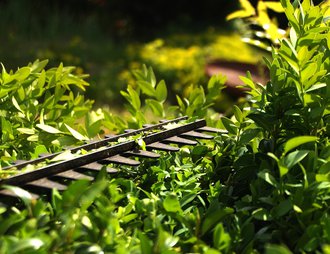Guide to maintenance of hedges

Used since Neolithic times to create enclosures around cultivated areas, hedges are still grown today next to gates and fences to hide private properties from view and keep out noise; also to provide shade or form a windbreak, or simply to embellish a garden with foliage, flowers and berries for added colour.
But which are the plants most suitable for growing hedges? And how can we keep them healthy and luxuriant? Here are a few pointers.
Which plants to use, and why

In reality, there are no "hedge" plants in nature. It all depends on the purpose the hedge is to serve, the space you have available and the amount of sunlight it will get. If the main object of the exercise is to create a decorative feature, you could plant a deciduous hedge, which will also blossom wonderfully in the warm season. If on the other hand you want simply to put up a screen that will defend your privacy from prying eyes all year round, then evergreen plants will be best. Finally, if you are especially tight for space, avoid plants that produce vigorous growth and go for dwarf hedges.
When to plant and how to lay out
The ideal time to plant hedges is during the period from Autumn to early Spring. First of all, dig the soil to a good depth and add a natural fertilizer that will enrich it with organic matter. If the soil is particularly compact, soften it up by adding a little sand, which will favour oxygenation and drainage, then mark out the line along which the plants are to be put in. Always give preference to young plants that will take root easily in the soil, adapting readily to the shape you want to give them, and make certain they are planted all at the same time so as to avoid uneven growth. Ensure the single plants are suitably spaced apart, allowing for the size they are likely to reach over time; this will ensure there is no undesirable congestion later on.
Upkeep and tools
Terminate le operazioni di semina, dovrai preoccuparti di far crescere le tue piantine e mantenerle in salute. Per farlo, non dimenticare mai di annaffiarle regolarmente in particolar modo durantel’estate e in fase di attecchimento, così da scongiurare qualsiasi tipo di stress alla siepe dopo il trapianto. Per mantenere il terreno umido, puoi ricorrere anche alla pacciamatura con corteccia o cippato.
Once the plants have grown to full size, they will need pruning back occasionally; this strengthens them and ensures that the hedge does not develop dry growth or unsightly gaps. How often hedges are pruned will depend a good deal on the type of plant selected, but in general, assume at least twice a year, especially for fast-growing types such as cherry laurel — Prunus Laurocerasus — a popular choice for privacy hedging.
Branches can be cut with suitable precision directly by hand, using pruning shears, or shears. Always select a model with ergonomic handgrip, which will ensure you can hold the branch steady without any strain on the wrist. For example, Efco offers COMFORT or UNIVERSAL shears which feature aluminium handles and anvil to guarantee long and durable service.
Once pruning operations have been completed, use a leaf blower to clear away the dead branches and foliage, so they will not remain lodged in the hedge and dry up. In the case of large and thick hedges, the work load is too heavy to be using hand tools: it requires a petrol engine hedgetrimmer or a professional hedgetrimmer, as the plants must be kept trimmed to the proper size and prevented from growing inordinately large, to the point of occupying much more space than originally intended.
If your needs go no further than looking after a garden hedge, the electric hedgetrimmer will be perfect: quiet running — and cordless, if battery powered — it can be taken anywhere and used at any hour of the day, without disturbing the neighbours.



